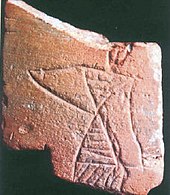Gaṇikā

Gaṇikā or ganika (Devanagari: गणिका) were women entertainers in early India. Their origin can be traced to the Vedic period. Dancers of Ancient India known as ganikas were prominent in city life.
In early India, the word "ganika" referred to a courtesan or public dancer, though the word was occasionally also used for prostitutes.[1][2]
Ganikas were trained in fine arts like dance and music in order to entertain kings, princes, and other wealthy patrons on religious and social occasions.[3] A woman would earn the title of "Ganika" if, alongside being seen as beautiful, she became versed in the 64 parts of Kalā. This title also granted a seat of honour in an assemblage of men.[4]When a Ganika lives with her lover, she maintains the relationship like a wife.[5]
References[edit]
- ^ "Mujra, a misunderstood concept". www.esamskriti.com. Retrieved 2023-12-20.
- ^ www.wisdomlib.org (2014-08-03). "Ganika, Gaṇika, Gaṇikā: 28 definitions". www.wisdomlib.org. Retrieved 2023-12-20.
- ^ "The Ganika in Buddhist and Jaina literature". INDIAN CULTURE. Retrieved 2023-12-20.
- ^ "The Kama Sutra of Vatsyayana: Part I: Introductory: Chapter III. On the Study of the Sixty-Four Arts". sacred-texts.com. Retrieved 2023-12-20.
- ^ "CHAPTER II OF LIVING LIKE A WIFE".
